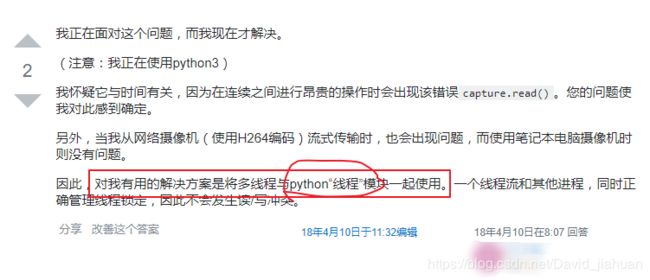python代码实现Opencv调用海康Rtsp视频流,进行人脸检测
代码都是开源的代码,用的是opencv的DNN人脸检测算法。
测试过程中的所用到的模块的版本:
python (3.5.1)
opencv-python (4.1.2.30)
opencv-contrib-python (4.1.2.30)
1、先贴出第一版本的代码:
from __future__ import division
import cv2
import time
import sys
def detectFaceOpenCVDnn(net, frame):
frameOpencvDnn = frame.copy()
frameHeight = frameOpencvDnn.shape[0]
frameWidth = frameOpencvDnn.shape[1]
blob = cv2.dnn.blobFromImage(frameOpencvDnn, 1.0, (300, 300), [104, 117, 123], False, False)
net.setInput(blob)
detections = net.forward()
bboxes = []
for i in range(detections.shape[2]):
confidence = detections[0, 0, i, 2]
if confidence > conf_threshold:
x1 = int(detections[0, 0, i, 3] * frameWidth)
y1 = int(detections[0, 0, i, 4] * frameHeight)
x2 = int(detections[0, 0, i, 5] * frameWidth)
y2 = int(detections[0, 0, i, 6] * frameHeight)
bboxes.append([x1, y1, x2, y2])
cv2.rectangle(frameOpencvDnn, (x1, y1), (x2, y2), (0, 255, 0), int(round(frameHeight/150)), 8)
return frameOpencvDnn, bboxes
if __name__ == "__main__" :
DNN = "TF"
if DNN == "CAFFE":
modelFile = "res10_300x300_ssd_iter_140000_fp16.caffemodel"
configFile = "deploy.prototxt"
net = cv2.dnn.readNetFromCaffe(configFile, modelFile)
else:
modelFile = "opencv_face_detector_uint8.pb"
configFile = "opencv_face_detector.pbtxt"
net = cv2.dnn.readNetFromTensorflow(modelFile, configFile)
conf_threshold = 0.7
source = "rtsp://***:***@192.168.**.**:554/h264/ch1/main/av_stream"
if len(sys.argv) > 1:
source = sys.argv[1]
cap = cv2.VideoCapture(source)
hasFrame, frame = cap.read()
vid_writer = cv2.VideoWriter('output-dnn-{}.avi'.format(str(source).split(".")[0]),cv2.VideoWriter_fourcc('M','J','P','G'), 15, (frame.shape[1],frame.shape[0]))
frame_count = 0
tt_opencvDnn = 0
while(1):
hasFrame, frame = cap.read()
if not hasFrame:
break
frame_count += 1
t = time.time()
outOpencvDnn, bboxes = detectFaceOpenCVDnn(net,frame)
tt_opencvDnn += time.time() - t
fpsOpencvDnn = frame_count / tt_opencvDnn
label = "OpenCV DNN ; FPS : {:.2f}".format(fpsOpencvDnn)
cv2.putText(outOpencvDnn, label, (10,50), cv2.FONT_HERSHEY_SIMPLEX, 1.4, (0, 0, 255), 3, cv2.LINE_AA)
cv2.imshow("Face Detection Comparison", outOpencvDnn)
vid_writer.write(outOpencvDnn)
if frame_count == 1:
tt_opencvDnn = 0
k = cv2.waitKey(10)
if k == 27:
break
cv2.destroyAllWindows()
vid_writer.release()
注:上面关于rtsp流的地址,请改为自己摄像机的地址!
2、在上面的这个例子执行过程中,会发现当检测到人脸时,程序会断开并提示报错信息:
error while decoding MB 78 12, bytestream -5
这个报错信息中的数字可能会与你的不太一样,但是大致的意思是跟python线程有关:
于是接着搜索 “python多线程使用”,然后经过修改和调试后的最新版本:
from __future__ import division
import cv2
import time
import sys
import queue
import threading
q = queue.Queue()
def detectFaceOpenCVDnn(net, frame):
frameOpencvDnn = frame.copy()
frameHeight = frameOpencvDnn.shape[0]
frameWidth = frameOpencvDnn.shape[1]
blob = cv2.dnn.blobFromImage(frameOpencvDnn, 1.0, (300, 300), [104, 117, 123], False, False)
net.setInput(blob)
detections = net.forward()
bboxes = []
for i in range(detections.shape[2]):
confidence = detections[0, 0, i, 2]
if confidence > conf_threshold:
x1 = int(detections[0, 0, i, 3] * frameWidth)
y1 = int(detections[0, 0, i, 4] * frameHeight)
x2 = int(detections[0, 0, i, 5] * frameWidth)
y2 = int(detections[0, 0, i, 6] * frameHeight)
bboxes.append([x1, y1, x2, y2])
cv2.rectangle(frameOpencvDnn, (x1, y1), (x2, y2), (0, 255, 0), int(round(frameHeight/150)), 8)
return frameOpencvDnn, bboxes
def receive():
print("start Receive")
source = "rtsp://***:***@192.168.**.**:554/h264/ch1/sub/av_stream"
if len(sys.argv) > 1:
source = sys.argv[1]
cap = cv2.VideoCapture(source)
hasFrame, frame = cap.read()
q.put(frame)
while(hasFrame):
hasFrame, frame = cap.read()
q.put(frame)
def display():
print("start Display")
frame_count = 0
tt_opencvDnn = 0
while(1):
if q.empty() != True:
frame = q.get()
frame_count += 1
t = time.time()
outOpencvDnn, bboxes = detectFaceOpenCVDnn(net,frame)
tt_opencvDnn += time.time() - t
fpsOpencvDnn = frame_count / tt_opencvDnn
label = "OpenCV DNN ; FPS : {:.2f}".format(fpsOpencvDnn)
cv2.putText(outOpencvDnn, label, (10,50), cv2.FONT_HERSHEY_SIMPLEX, 1.4, (0, 0, 255), 3, cv2.LINE_AA)
cv2.imshow("Face Detection Comparison", outOpencvDnn)
vid_writer.write(outOpencvDnn)
if frame_count == 1:
tt_opencvDnn = 0
k = cv2.waitKey(10)
if k == 27:
break
if __name__ == "__main__" :
# OpenCV DNN supports 2 networks.
# 1. FP16 version of the original caffe implementation ( 5.4 MB )
# 2. 8 bit Quantized version using Tensorflow ( 2.7 MB )
DNN = "TF"
if DNN == "CAFFE":
modelFile = "res10_300x300_ssd_iter_140000_fp16.caffemodel"
configFile = "deploy.prototxt"
net = cv2.dnn.readNetFromCaffe(configFile, modelFile)
else:
modelFile = "opencv_face_detector_uint8.pb"
configFile = "opencv_face_detector.pbtxt"
net = cv2.dnn.readNetFromTensorflow(modelFile, configFile)
conf_threshold = 0.7
source = "rtsp://***:***@192.168.**.**:554/h264/ch1/sub/av_stream"
if len(sys.argv) > 1:
source = sys.argv[1]
cap = cv2.VideoCapture(source)
hasFrame, frame = cap.read()
vid_writer = cv2.VideoWriter('output-dnn-{}.avi'.format(str(source).split(".")[0]),cv2.VideoWriter_fourcc('M','J','P','G'), 15, (frame.shape[1],frame.shape[0]))
p1 = threading.Thread(target = receive)
p2 = threading.Thread(target = display)
p1.start()
p2.start()
cv2.destroyAllWindows()
vid_writer.release()其实细心的朋友可能已经发现,我调用的rtsp的视频流地址source已经由第一个版本的main主码流改为了sub辅码流,这是因为主码流的视频分辨率是1080P的,对于我这太笔记本来说,处理起来相当吃力;所以我为了降低视频分辨率,改成了获取实时辅码流sub!
